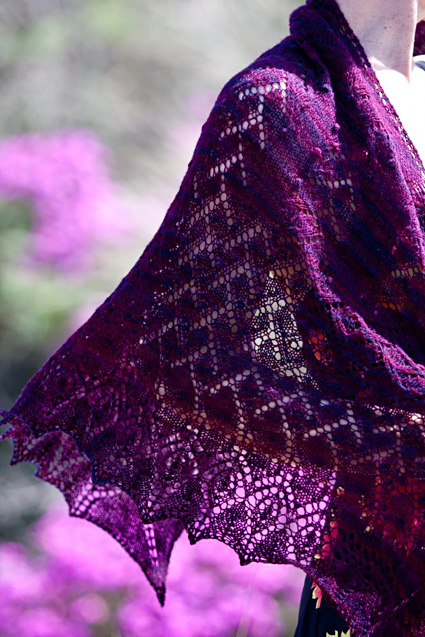

|

Nature is both destructive and creative. When my home town of Christchurch, New Zealand was struck by a series of devastating earthquakes beginning September 4th 2010, the entire CBD was cordoned off from public access as the many damaged and collapsed buildings were demolished or repaired. Large swaths of residential Christchurch were left ruined and uninhabitable, forcing people from their beloved riverside houses and gardens to more seismically stable ground. |
||
Tweet

|
||
|
SIZE |
|
|
FINISHED MEASUREMENTS |
|
MATERIALS
Note: While Kia Ora Kiwi Laceweight is labelled 'Laceweight', it is on the heavier end of laceweight yarn. If you wish to substitute yarns, a 3-ply yarn or other laceweight would be a suitable substitute, but may produce a shawl with slightly smaller or larger dimensions. Knit a swatch to determine preferred gauge and needle size.
Tools |
|||||
|
GAUGE |
| 22 sts/34 rows = 4 inches in stockinette stitch, after blocking 24 sts/32 rows = 4 inches in pattern stitch, after blocking |
|
PATTERN NOTES |
|
The motifs in this shawl were inspired by stitch patterns from Knitted Lace of Estonia, Techniques, Patterns and Traditions, by Nancy Bush (2008). The Riotous Vine chart is derived from Hagakiri 2, and the Creeping Vine chart is a modification of that. The Crowning Glory chart is a modification of two edge stitches and some fortuitous mistakes. If you wish to use stitch markers to identify the beginning and end of blocks of repeating pattern, and it is recommended that you do, please note these markers will need to move on some rows when working decreases. You can make a smaller (or larger) shawl by NOT knitting chart 2a and 2b (Creeping Vine Transition) and 3a and 3b (Creeping Vine Right and Left) a second time through. Instead, work row 73, the transitional row to chart 4a and 4b (Riotous Vine Left and Right). For a larger shawl, repeat charts 2a and 2b a third time, charts 3a and 3b a third time, then work transitional row 73 followed by chart 4a and 4b. Nupps (optional): 7 stitch nupps are used in this shawl. You could alternately use 5 or 9 stitch nupps depending on the yarn you choose. This shawl is labelled piquant simply due to the addition of nupps, if you find nupps too challenging, simply omit them altogether and treat the nupp stitch as a regular knit stitch. Knitting should be fun, not frustrating! 7 stitch nupp: Working very loosely, working into the next stitch as follows: (k1, yo) 3 times, k1 once more. 1 st is increased to 7 sts. On the returning WS purl row, purl all 7 sts together. To successfully purl the nupp sts together they must be knit loosely on the preceding knit row. Working from the charts and pattern repeats: |
The charts for this pattern are very large. Each fits on a letter-sized page. Click below and print each resulting page. 1a | 1b |2a & 2b | 3a & 3b | 4a | 4b | 5a | 5b |
|
DIRECTIONS Next row [RS]: K2, pick up and knit 3 sts in the garter ridges along the side of the tab; pick up and knit 2 sts in the cast on edge. 7 sts. Shawl Body:Creeping Vine Startup Row 1 [RS]: K2, yo, k1, yo, pm, k1, pm, yo, k1, yo, k2. 11 sts. Rows 2, 4, 6, 8 [WS]: K2, p to last 2 sts, k2. Row 3 [RS]: K2, yo, k3, yo, k1, yo, k3, yo, k2. 15 sts. Row 5 [RS]: K2, yo, k5, yo, k1, yo, k5, yo, k2. 19 sts. Row 7 [RS]: K2, yo, k7, yo, k1, yo k7, yo, k2. 23 sts. Body of Shawl Work as set until Charts 1a and 1b are complete. 103 sts. Next row [RS]: K2, yo, work Chart 2a across to center st (working Pattern Repeat once), yo, k1, yo, work Chart 2b across to last 2 sts (working Pattern Repeat once), yo, k2. Work as set until Charts 2a and 2b are complete. 127 sts. Next row [RS]: K2, yo, work Chart 3a across to center st (working Pattern Repeat twice), yo, k1, yo, work Chart 3b across to last 2 sts (working Pattern Repeat twice), yo, k2. Work as set until row 72 (yes, 72; this is not a typo!) of Charts 3a and 3b is complete. 183 sts. Work Charts 4a & 4b, working Pattern Repeat 12 times across. 347 st. Work Charts 5a & 5b, working Pattern Repeat 16 times across. 457 st. Bind off loosely as follows: K1; *k1, slip the 2 sts back to the left needle, and knit them together ktbl; rep from * until 1 st rems; Cut yarn and pull through final st to secure. |
|
FINISHING |
| ABOUT THE DESIGNER |
|
Mary-Anne Mace lives the good life in Christchurch, New Zealand, a city that shakes from time to time, but which is full of possibilities and new beginnings. |
|
Pattern & images © 2014 Mary-Anne Mace. Contact Mary-Anne |